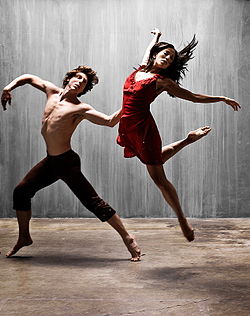
Modern Dance is related to ballet, but aims at different types of performance, instead of the classical ballets. Many of its dancers have been trained in ballet, and modern dance companies are rather similar to ballet companies.
The phrase 'Modern dance' is also applied to Ballroom dance of the English (now 'International') style. However, this page uses Modern dance as a term to describe 20th century concert dance, on stage. The modern dance style does not have set rules. Modern dancers often create their own dance routines using their emotions and moods, but on the other hand, many performances are choreographed.
Modern dancers prefer a more relaxed and free style of dancing. While ballerinas try to be light on their feet, modern dancers use body weight to increase movement. Also modern dancing does not require specific costumes. So modern dancers often dance barefoot and choose whatever they want to wear. Modern dancers try to show their innermost emotions through dancing, often trying to get closer to their inner-selves. This is why many modern dancers choose a subject that is close to their hearts and attempts to express the subject to the audience.
History[]
Modern Dance was developed in the 20th century, mainly in the United States and Germany. In the early 1900s, several female dancers began rebelling against the strict rules of classical ballet. The pioneers of Modern Dance in the United States were Isadora Duncan, Loie Fuller, Ruth St. Denis and Martha Graham. The pioneers of Germany were Rudolf Von Laban and Mary Wigman.
Five examples[]
- Loie Fuller (1862–1928) was a burlesque skirt dancer. She began experimenting with the effect that gas lighting had on her silk costumes. Fuller developed a form of natural movement and improvisation techniques that were used in conjunction with her revolutionary lighting equipment and translucent silk costumes. She patented her apparatus and methods of stage lighting that included the use of coloured gels and burning chemicals for luminescence, and also patented her voluminous silk stage costumes.
- Isadora Duncan (1877–1927) was an original dancer and an extraordinary personality. She invented a dance style based on natural flowing motions and flowing silk dresses and scarves. She strongly criticised ballet as unnatural, and insisted on complete freedom for herself. This included public drunkenness, love affairs with both men and women, and a flirtation with communism. Both she and her first two children died in freak accidents involving cars. The children died when their chauffer got out of the car to hand-crank the engine, but forgot the brake. The car, with the children inside, slipped backwards into the Seine. She herself died when her famous scarf got wrapped round the wheel of a moving car.
- Martha Graham (1894–1991) was an American modern dancer and choreographer. Her influence on dance has been compared with the influence Picasso had on modern visual arts, Stravinsky had on music, or Frank Lloyd Wright had on architecture. She danced and choreographed for over seventy years. She choreographed about 100 works.
- Katherine Dunham (1909–2006) was an African American dancer and anthropologist. Originally a ballet dancer, she founded her first company Ballet Negre in 1936 and later the Katherine Dunham Dance Company based in Chicago, Illinois. Dunham opened a school in New York (1945) where she taught Katherine Dunham Technique, a blend of African and Caribbean movement (flexible torso and spine, articulated pelvis and isolation of the limbs and polyrhythmic movement) integrated with techniques of ballet and modern dance.
- Merce Cunningham (1919–2009) was a former ballet student and performer with Martha Graham. He presented his first New York solo concert with John Cage in 1944. Influenced by Cage and embracing modernist ideology using postmodern processes, Cunningham introduced chance procedures and pure movement to choreography and Cunningham technique to the book of 20th century dance techniques. Cunningham set the seeds for postmodern dance with his abstract work. In these works each element is expressive, and the viewer decides what it means. Cunnimgham choreographed nearly 200 works for his dance company.